Bass reflex
A bass reflex system (also known as a ported, vented box or reflex port) is a type of loudspeaker enclosure that uses a port (hole) or vent cut into the cabinet and a section of tubing or pipe affixed to the port. This port enables the sound from the rear side of the diaphragm to increase the efficiency of the system at low frequencies as compared to a typical sealed- or closed-box loudspeaker or an infinite baffle mounting.
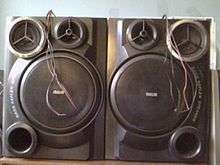
A reflex port is the distinctive feature of this popular enclosure type. The design approach enhances the reproduction of the lowest frequencies generated by the woofer or subwoofer. The port generally consists of one or more tubes or pipes mounted in the front (baffle) or rear face of the enclosure. Depending on the exact relationship between driver parameters, the enclosure volume (and filling if any), and the tube cross-section and length, the efficiency can be substantially improved over the performance of a similarly sized sealed-box enclosure.
Explanation
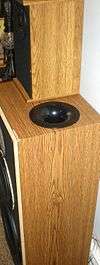
Unlike closed-box loudspeakers, which are nearly airtight, a bass reflex system has an opening called a port or vent cut into the cabinet, generally consisting of a pipe or duct (typically circular or rectangular cross section). The air mass in this opening resonates with the "springiness" of the air inside the enclosure in exactly the same fashion as the air in a bottle resonates when a current of air is directed across the opening. Another metaphor often used is to think of the air like a spring or rubber band. The frequency at which the box/port system resonates, known as the Helmholtz resonance, depends upon the effective length and cross sectional area of the duct, the internal volume of the enclosure, and the speed of sound in air. In the early years of ported speakers, speaker designers had to do extensive experimentation to determine the ideal diameter of the port and length of the port tube or pipe; however, more recently, there are numerous tables and computer programs that calculate, for a given size of cabinet, how large the port should be and how long the tube should be. Even with these programs, however, some experimentation with prototypes is still necessary to determine if the enclosure sounds good.
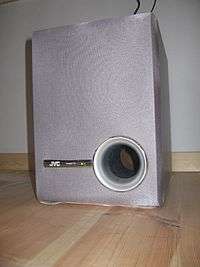
If this vent air mass/box air springiness resonance is so chosen as to lie lower in frequency than the natural resonance frequency of the bass driver, an interesting phenomenon happens: the backwave of the bass driver sound emission is inverted in polarity for the frequency range between the two resonances. Since the backwave is already in opposite polarity with the front wave, this inversion brings the two emissions in phase (although the vent emission is lagging by one wave period) and therefore they reinforce each other. This has the useful purpose of producing higher output (for any given driver excursion compared to a closed box) or, conversely, a similar output with a smaller excursion (which means less driver distortion). The penalty incurred for this reinforcement is time smearing: in essence the vent resonance augments main driver output by imposing a "resonant tail" on it. For frequencies above the natural resonance of the driver, the reflex alignment has no influence. For frequencies below the vent resonance, polarity inversion is not accomplished, and backwave cancellation occurs. Furthermore, the driver behaves as though suspended in free air, as box air springiness is absent.
When speakers are designed for home use or for high-volume live performance settings (e.g., with bass amplifier speaker cabinets and PA system speakers and subwoofers), manufacturers often consider the advantages of porting (increased bass response, lower bass response, improved efficiency) to outweigh the disadvantages (port noise, resonance problems). The design is popular among consumers and manufacturers (speakers cabinets can be smaller and lighter, for more or less equivalent performance) but the increase in bass output requires close matching of driver, the enclosure, and port. Poorly matched reflex designs can have unfortunate characteristics or drawbacks, sometimes making them unsuitable for settings requiring high accuracy and neutrality of sound, e.g. studio monitor speakers for use by audio engineers in monitoring facilities, recording studios etc. However it is possible to design a bass reflex system that mostly overcomes these drawbacks; and quality bass reflex designs are commonly found in demanding environments across the world.
Comparison with passive radiator
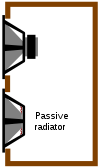
Passive radiators are "similar in operation to ported" bass reflex systems, and both methods are used for the same reason: to "...extend the [speaker cabinet] system's low frequency response."[1] "By far, the port is the most common means of extended bass response in a cabinet. The second most common bass extender for loudspeakers is called a passive radiator".[2] A passive radiator is the use of one or more additional cones (diaphragms) in a cabinet instead of ports. These passive diaphragms do not have a magnet or voice coil and are not connected to the power amplifier. Passive radiators are also called "drone cones".
History
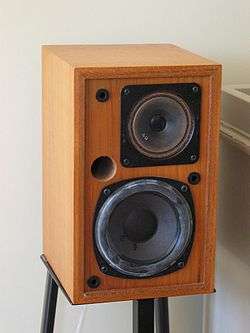
The effect of the various speaker parameters, enclosure sizes and port (and duct) dimensions on the performance of bass reflex systems was not well understood until the early 1960s. At that time, pioneering analyses by A.N. Thiele[3] and Richard H. Small[4] related these factors in a series of "alignments" (sets of the relevant speaker parameters) that produced useful, predictable responses. These made it possible for speaker manufacturers to design speakers to match various sizes of enclosures, and to match enclosures to given speakers with great predictability. All of this is constrained by the laws of physics, which is covered in detail in Thiele and Small's work. It is not possible to have a small speaker in a small enclosure producing extended bass response at high efficiencies (i.e., requiring only a low-powered amplifier). It's possible to have two of these attributes, but not all; this has been termed Hofmann's Iron Law after J. Anton Hofmann of KLH's summary (with Henry Kloss) of Edgar Villchur work years earlier. The sound pressure produced depends upon the efficiency of the speaker, the mechanical or thermal power handling of the driver, the power input and the size of the driver.
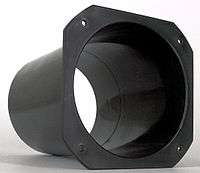
Advantages
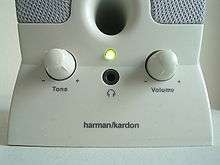
Such a resonant system augments the bass response of the driver and, if designed properly, can extend the frequency response of the driver/enclosure combination to below the range the driver would reproduce in a similarly sized sealed box. The enclosure resonance has a secondary benefit in that it limits cone movement in a band of frequencies centered around the tuning frequency, reducing distortion in that frequency range. Ported cabinet systems are cheaper than a passive radiator speaker with the same performance; whereas a passive radiator system requires one or two "drone cone" speakers, a ported system requires only a hole or port and a length or tubing.
Limitations
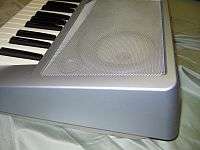
Bass reflex cabinets have relatively poor transient response, causing "smearing" or a longer resonance of the bass notes. Though the sound coming out of the port may have the same phase of that from the front surface, but it can never be at the same time, thus, the extended bass energy is really noise disguised as signal. The disguise works only when the sound is a continuous tone (one of the reasons why some people prefer some particular kind of music for their audio system), but reveals itself most apparently at reproducing percussion sound. For the same reason, Linkwitz-Riley crossover has the same issue.
The low frequency driver in a resonant speaker enclosure system such as a ported cabinet or passive radiator cabinet cannot start and stop instantly like it can in a sealed-box cabinet. In order to achieve their bass output, ported speaker enclosures stagger two resonances. One from the driver and boxed air and another from the boxed air and port. This a more complex case than an equivalent sealed box. It causes increased time delay (increased group delay imposed by the twin resonances), both in the commencement of bass output and in its cessation. Therefore, a flat steady-state bass response does not occur at the same time as the rest of the sonic output. Instead, it starts later (lags) and accumulates over time as a longish resonant "tail". Because of this complex, frequency-dependent loading, ported enclosures generally result in poorer transient response at low frequencies than in well-designed sealed-box systems. Another issue is that a large cabinet will require a long port tube to be tuned properly, which means that bass reflex cabinets may be larger than a passive radiator cabinet with similar performance.
Another trade-off for this augmentation is that, at frequencies below 'tuning', the port unloads the cone and allows it to move much as if the speaker were not in an enclosure at all. This means the speaker can be driven past safe mechanical limits at frequencies below the tuning frequency with much less power than in an equivalently sized sealed enclosure. For this reason, high-powered systems using a bass reflex design are often protected by a filter that removes signals below a certain frequency. Unfortunately, electrical filtering adds further frequency-dependent group delay. Even if such filtering can be adjusted not to remove musical content, it may interfere with sonic information connected with the size and ambiance of the recording venue, information which often exists in the low bass spectrum.
Whether or not the effects of these in a properly designed system are audible remains a matter of debate. A poorly designed bass reflex system, generally one that is tuned too high or too loosely, can ring at the tuning frequency and create a 'booming' one-note quality to the bass frequencies. In effect, this is due to the port resonance imposing its characteristics to the note being played, and is grossly exacerbated if the port resonance coincides with one of the resonant modes of the room, a not unusual occurrence. In general, the lower in frequency a port is tuned, the less objectionable these problems are likely to be.
Ports often are placed in the front baffle, and may thus transmit unwanted midrange frequencies reflected from within the box. If undersized, a port may also generate "wind noise" or "chuffing", due to turbulence around the port openings at high air speeds. Enclosures with a rear-facing port mask these effects to some extent, but they cannot be placed directly against a wall without causing audible problems. They require some free space around the port so they can perform as intended. Some manufacturers incorporate a floor-facing port within the speaker stand or base, offering predictable and repeatable port performance within the design constraints.
Port compression
Port compression is a reduction in port effectiveness as sound pressure levels increase. As a ported system plays louder, the efficiency of the port reduces, and distortion emitted by the port increases. This can be reduced by port design, but not totally eliminated. Asymmetrical loading of the driver cone during high level usage can be reduced by placing a baffle at the inside end of the port tube. This baffle can also serve as a stiffening structural element of the enclosure.
Applications
Subwoofer cabinets used in home cinema and sound reinforcement systems are often fitted with ports or vents. Bass amp speaker cabinets and keyboard amp speaker cabinets, which have to reproduce low-frequency sounds down to 41 Hz or below, are often built with ports or vents, which are typically on the front of the cabinet (though they are also placed on the rear). Even some expensive hi-fi speakers have carefully designed ports.
See also
References
- "The Subwoofer DIY Page - Passive Radiator Systems". www.diysubwoofers.org. Retrieved 2019-11-20.
- McGowan, Paul (April 30, 2013). "Passively radiating". psaudio.com. Retrieved 2019-11-20.
- Thiele, A. N., "Loudspeakers in Vented Boxes: Parts I and II," J. Audio Engineering Soc., Vol 19, No. 5, May 1971, pp 382-392 (Reprinted from a 1961 publication in Proc. IRE Australia).
- Small, Richard H., "Vented-Box Loudspeaker Systems, Part I: Small-Signal Analysis", J. Audio Engineering Soc., Vol 21, No. 5, June 1973, pp 363-444.